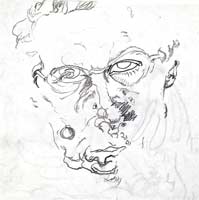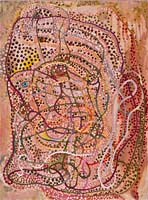5. Form and content
« Our admiration for painting results from a long adaptation process, which took place during centuries and for reasons which have often nothing to do with art or spirit. Painting created its recipients. It is fundamentally a conventional relationship. We don’t believe any more in art but only in the idea of art. » Witold Gombrowitz
The foundation of form and content, or form and substance, constitutes the essence and the mystery of art. Conventions bring death to art. Each painting asks the question: how can form express a meaning or even an emotion? Conversely, how can ideas give birth to form? From the beginning, this yet unformulated question attracted me to cat’s cradles and the labyrinth. How did the drawing of the labyrinth find itself associated with so many myths that then gave way to a whole family of meanings? How does the image confer presence and flesh to the idea expressed by a myth?
But fundamentally, what is the content ? Is it an idea that can be expressed in words? With icons for example, ideas behind the images were presented by religions, but what remains of this today? There is no dogma about nature or the universe. Unless one indicates the content allegorically, which presents the inconvenient of breaking the direct relationship between form and substance, everything depends on perception. According to Roger Sheppard’s formula, «perception is a direct hallucination. The visual image undergoes a conditioning, whose importance can be measured by noting that 90% of the entries are not processed through the retina. »1Is the content then the examination of this conditioning? Is this the search for the “sensing” which Cézanne speaks about? : “The vision is what becomes visible of the invisible… to arrive at the landscape we must sacrifice as much possible all determinations, temporal, spatial, objective, but this abandonment does not only reach the objective, it affects ourselves in the same measure… we escape the objective world but also ourselves, that is the sensation”
The discovery of content in perception consists then in negating the primacy of the senses when they are only used to recognize an appearance or to label things. It consists in seeing how the sensible world escapes the principle of identity and contains its own negation.
Indeed, in all perception there is a blind or mute zone that can be called the invisible. “To see is always to see more than one sees “2. The gaze itself does not passively register, but occupies and hollows out what it aims at; it incorporates the content of an accumulated experience of dealing with things. Our perception is based then on our motility. In every perception there is a movement (see 4 Movement). The unseen or invisible idea is not accessible to another kind of vision, but to a questioning and a withdrawing of the conventional or utilitarian vision. A drawback that can manifest itself by a ‘coherent deformation' .
n°50 Auto portrait n°51 Portrait d'Otto
between these two self portrait which one is the most genuine ?
Without an explicit reference, how does one identify the content in such a deformed image, and what is the coherence in the deformation? The deformation makes us doubt the senses, it indicates an intention or subconscious work, but the idea remains on the horizon, and its reading seems dependent on subjective associations. Finally, in the search for the movement at the origin of deformation, it is the route followed which becomes primordial and revealing. Most often this route seems hazardous or interrupted; it only expresses reaction against imposed order.
It seems to me that the labyrinth presents a route leading to a truer aim. With the labyrinth consistently disrupting the knot, that consistency finally produce an idea. Beyond imbalance and dispersion, one moves towards a result like the one alchemy attributes to “circumambulation”:
“The circumambulation is the circulation of spirits or circular distillation, that is, the inner out, the outer in and the same for the highest and the lowest, and when they meet all together in a circle, one cannot recognize what is out and what is in, or at the top or at the base, but everything becomes a unique thing in a circle or in a vase. For this vase is the true ‘Pelican’ and none other is to be found in the entire universe”3. One can call this result the One.



